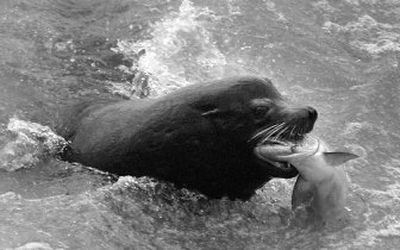States seek OK to kill sea lions

TACOMA – So far, California sea lions have been winning their contest for survival with the Washington and Oregon salmon heading upstream to spawn. That may be about to change.
Washington, Oregon and Idaho are asking Congress for permission to kill more than 80 sea lions a year to protect the salmon they feast on.
Since federal rules gave sea lions greater protection in the 1970s, the population of these salmon predators has grown as more gentle efforts have failed to scare them away from their favorite meal.
Sea lions on the Columbia River below Bonneville Dam have been blasted with rubber buckshot, chased by boats, harassed by firecrackers and rockets and subjected to noise from underwater speakers.
Both species have potent allies. Backing the salmon are the three Northwest states, American Indian tribes and four of the region’s members of Congress. Backing the sea lions is the 10 million-member Humane Society of the United States.
The confrontation involves two of the nation’s pre-eminent environmental laws: the Endangered Species Act and the Marine Mammal Protection Act.
“Its a frustrating dilemma,” said U.S. Rep. Brian Baird, D-Vancouver, who supports eliminating some of the sea lions. “I am not happy about it, but the trend lines show salmon runs decreasing and sea lion populations growing.”
State wildlife officials agree. “As resource managers, we face choices that sometimes aren’t desirable,” said Guy Norman, the Washington state Department of Fish and Wildlife’s regional director in Vancouver. “But we have to make these decisions.”
Prior to the passage of the Marine Mammal Protection Act in 1972, California sea lions were rarely seen in the 140-mile stretch of river between the Pacific Ocean and Bonneville Dam, the first of the 19 huge hydroelectric dams on the mainstream of the Columbia and its largest tributary, the Snake River.
The number of California sea lions dwindled to fewer than 10,000 before Congress acted. Until 1972, Washington and Oregon paid bounties for sea lions killed in the Columbia, and a state-sanctioned hunter was also employed.
Now an estimated 300,000 California sea lions live in the Pacific, chasing the food supply as far north as Puget Sound.
On a typical day, a dozen or so California sea lions can be spotted below Bonneville Dam, though as the spring chinook runs peak in late April, between 80 and 85 have been seen on a single day.
“There have always been some, but what is new is the number of sea lions and their aggressiveness,” said Brian Gorman, a National Marine Fisheries Service spokesman in Seattle. “They are doing what God intended them to – eating chinook. Salmon are easy pickings.”
As the California sea lion population was expanding, salmon populations were in sharp decline.
Once, an estimated 16 million salmon returned annually to the Columbia and its tributaries. Now, 13 salmon and steelhead species are protected under the Endangered Species Act.
“There is not a lot of room for error,” Norman said of the effort to revive the most endangered runs.
The California sea lions eat about 3,000 spring chinook each year just downstream from Bonneville Dam. The salmon spend several days in the river below the dam before climbing the fish ladders.
Each returning female salmon carries 3,000 to 4,000 eggs, so the loss of even one fish is multiplied.
In the mid-1990s, Washington state received a permit to kill some of the sea lions at the Ballard Locks, but Sea World in California took three of the worst offenders before they could be killed.
There have been no other applications for a license, other than the one submitted late last year by Washington, Oregon and Idaho.
“It is not the states’ contention that California sea lion predation is more significant than other sources of mortality to Columbia River ESA-listed salmonids, but simply it is significant and that it must be dealt with as are other sources of mortality,” the application said.